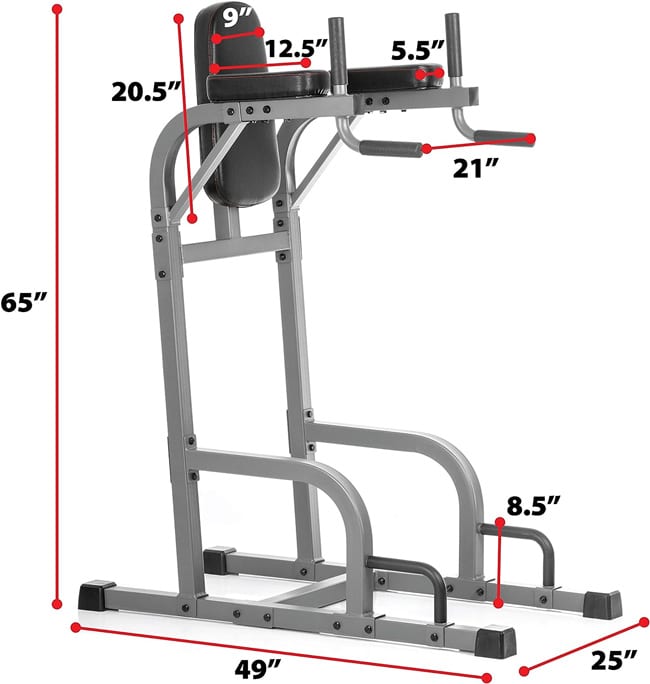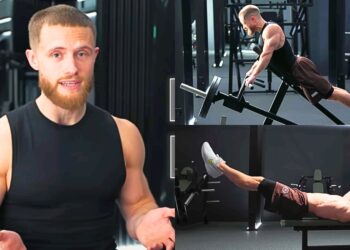Mention the captain’s chair to most gymgoers, and they probably won’t know what you’re talking about. Yet their gym has probably got at least one of them. Also known as the vertical knee raise, or VKR, machine, it’s the equipment you do knee raises and straight leg raises on.
Back in the bodybuilding heyday of the ‘70s and ‘80s, the captain’s chair was a mainstay in most ab and oblique workouts. In modern times, however, its popularity has dwindled. That’s a shame because this machine allows you to do some effective midsection exercises. I think it’s time to bring the captain’s chair back into the mainstream.
What is the Captain’s Chair?
The captain’s chair has a vertical frame with padded armrests and a back support. Home-use versions of the captain’s chair are often incorporated into a ‘power tower’ device, which includes a pull-up bar and push-up handles. Movements done on the captain’s chair involve suspending your body above the floor, with your elbows resting on the arm pads. Movement is primarily performed through hip extension to raise the legs or a crunching movement to work the abdominals.
The captain’s chair’s target muscle groups are the abdominals, obliques, intercostals, and hip flexors.

Captain’s Chair Exercises For a Ripped Midsection
Here are the best captain’s chair exercises for different muscle groups:
Exercises for the Rectus Abdominis
The rectus abdominis is a flat sheath of muscle in the front part of the stomach. Most of us want to develop and define this muscle to reveal our six-pack. It runs vertically from the pubic bone to the ribs. Its tendinous junctions separate it into segments. These sections are what give the six-pack appearance.
Level Up Your Fitness: Join our 💪 strong community in Fitness Volt Newsletter. Get daily inspiration, expert-backed workouts, nutrition tips, the latest in strength sports, and the support you need to reach your goals. Subscribe for free!
The function of the rectus abdominis is to draw the upper and lower bodies toward each other by contracting. Better posture, balance, and total spinal stability are all influenced by a strong rectus abdominis. This stability is vital for everyday movements and activities as well as more challenging exercises.
By helping preserve spinal alignment, a strong rectus abdominis can support the spine. This can lessen the strain on the lower back and reduce the risk of accidents brought on by bad posture.
Here are the two best captain’s chair exercises for the rectus abdominis:
1. Captain’s Chair Knee Raise
- Start by standing on the footrests of the captain’s chair, leaning your back against the backrest, and resting your arms on the armrests.
- Support yourself on your forearms and allow your legs to hang freely beneath you.
- Pull your belly button towards your spine to maintain a strong core. Maintain this level of contraction throughout the workout. This will be your starting position.
- Draw your knees up to your chest, aiming to reach waist level. In the top position, forcefully contract your abs. Do not swing your hips. Breathe in as you bring your knees up.
- Lower your legs under control to the start position. Exhale as you lower your legs.
2. Captain’s Chair Leg Raise
- Stand on the footrests, leaning your back against the backrest and resting your arms on the armrests.
- Lift off the footrests by pushing your shoulders down. Your body should be in a straight line at the starting position.
- Without bending your legs, pivot from the hips to bring your straight legs up, aiming to reach waist level.
- In the top position, contract your abs. Do not swing your hips. Breathe in as you bring your knees up.
- Lower your legs under control to the start position. Exhale as you lower your legs.
Exercises for Obliques
The oblique muscles are on the sides of the waist. They assist with core stability and trunk rotations and improve total functional fitness. The obliques are divided into external and internal groups.
The external obliques run diagonally from the lower ribs to the pelvis. They are responsible for twisting, rotation, and side-bending actions. The internal obliques are located under the external obliques and run diagonally in the opposite direction. They work with the external obliques to support rotational movements and stabilize the core.
3. Captain’s Chair Side Knee Raise
- Take your position on the captain’s chair.
- Bend your legs and pivot from the hips to bring your knees up to the right side of your body. Think about bringing your legs up toward your elbow.
- Lower your legs back to the start position. Exhale as you lower your legs.
- On the next rep, bring your legs up on the left side.
4. Captain’s Chair Oblique Twist
- Get into position on the captain’s chair.
- Draw your knees up to the right side of your body. Think about bringing your knees up toward your elbow.
- As your knees reach their highest point, initiate the twist by engaging your oblique muscles. Rotate your hips and legs to the opposite side, bringing your knees up towards your opposite elbow.
- Pause to feel a deep contraction in the obliques where your knees are closest to the opposite knee.
- Lower under control, exhaling on the way down.
- Alternate sides between reps.
Isometric Holds
Isometric hold exercises involve holding a static position for an extended period. This type of exercise can strengthen the working muscle in its shortened position. Combing isometric and dynamic mid-section exercises will ensure complete development.
5. Captain’s Chair L-Sit
- Assume the starting position on the captain’s chair.
- Without bending your legs, pivot from the hips to bring your straight legs up, aiming to reach waist level.
- Your body should resemble an ‘L’ in this position. Hold this position and contract your abs.
- Start with five-second holds and gradually increase to 20 seconds. Hold your breath during the isometric hold.
- Lower under control. Breathe out during the descent.
6. Captain’s Chair Knee Hold Crunch
- Take your position on the captain’s chair.
- Draw your knees up toward your chest.
- At the same that you draw your knees up, curl your trunk forward to bring your chest down toward your knees.
- Hold the contracted position for three seconds.
- Lower under control.
Dynamic Movements for a Functional Core
Contrary to isometric exercises, dynamic exercises involve momentum. Captain’s chair dynamic exercises can help build core strength because they work the rectus abdominis, the obliques, and the hip flexors.
Level Up Your Fitness: Join our 💪 strong community in Fitness Volt Newsletter. Get daily inspiration, expert-backed workouts, nutrition tips, the latest in strength sports, and the support you need to reach your goals. Subscribe for free!
Dynamic exercises require you to move through an extended range of motion, which helps increase your core’s flexibility and mobility. Dynamic exercises add diversity to your main workouts, keeping things exciting.
7. Captain’s Chair Bicycle Crunch
- Assume the starting position on the captain’s chair.
- Bring your bent right knee up, aiming to reach waist level. Keep the left leg straight. In the top position, forcefully contract your abs. Do not swing your hips. Breathe in as you bring your knees up.
- Bring your right knee towards your chest.
- As you return your right leg to the starting position, immediately switch to the left side. Extend your right leg and bring your left knee towards your chest.
8. Captain’s Chair Side Leg Raise
- Get into the Captain’s chair starting position.
- Slowly raise your legs together diagonally to one side while keeping them straight.
- Return to the starting position.
- Alternate between sides for the recommended reps.
Total Core Integration
Captain’s chair core integration exercises train multiple muscle groups and improve total core strength, stability, and coordination. These exercises combine the core with other muscle groups, making them functional and applicable to everyday tasks. The captain’s chair plank and the hanging leg lift are two excellent core integration exercises performed on the captain’s chair.
9. Captain’s Chair Plank
- Take the starting position on the captain’s chair.
- Start by lifting your legs in front of you, keeping them parallel to the floor.
- Lean your upper body back slightly.
- Shift your weight onto your forearms and upper arms. Drive your elbows and upper arms into the armrests while lowering your legs slightly.
- Your body should be in a straight line from head to heels, angled at about 30 degrees.
- Hold this plank position for 30 seconds.
10. Hanging Leg Circle
- Get into position on the captain’s chair.
- Lift your legs in front of you, keeping them straight, and lean back slightly.
- Start moving your legs in a circular motion below the captain’s chair’s arms. Bring your legs to the right, then down and around in a circle, and then up to the opposite side before returning to the starting position.
- Perform all your reps circling to the right and repeat on the left in the next set.
Designing a Comprehensive Core Workout
You can develop a structured training program using these 10 captain’s chair exercises to improve your general fitness and core strength. Your program should include progression and recovery to maximize long-term outcomes while lowering the risk of injury and burnout.
Here is a step-by-step guide to creating your own captain’s chair workout:
- Exercise Selection: Select a range of exercises that work the upper, lower, and oblique muscles to strengthen all parts of the core. Incorporate a mix of isometric and dynamic movements.
- Frequency: Work your core on the captain’s chair twice or thrice weekly. Allow a day’s rest between workouts for sufficient recovery.
- Sets and Reps: Do 10-15 reps for three sets per exercise.
- Progression: Progressively overload your muscles by doing more sets and reps, more challenging exercise variations, or adding resistance. It will ensure consistent growth and help avoid plateaus.
- Recovery: Rest is essential to prevent overtraining and injury. Recovery entails getting enough rest, staying hydrated, and adding rest days to your schedule.
Sample Captain’s Chair Workout:
| Exercises | Sets | Reps |
| Captain’s Chair Knee Raise | 2 | 10-15 |
| Captain’s Chair Oblique Twist | 2 | 10-15 |
| Captain’s Chair Knee Hold Crunch | 2 | 10-15 |
| Captain’s Chair Bicycle Crunch | 2 | 10-15 |
| Captain’s Chair Plank | 2 | 5-20 second hold |
Proper Form and Safety Precautions
Keeping good form while performing the captain’s chair exercises is essential for workout efficiency and avoiding injuries. Using the wrong form can result in strains, pain, and even potential injuries. Here are some tips to help you keep your form on point:
- Start slow: If you are new to the captain’s chair, start slowly and increase your training volume as your strength and comfort levels rise. Muscle strain risk increases when advanced moves, such as the L-Sit, are rushed into without a solid base.
- Maintain a neutral spine: Keep your back flat on the machine’s backrest. Lower back discomfort from arching the lower back should be avoided. Contract your core muscles to help your spine stay in place.
- Avoid momentum: Use controlled motions to raise and lower your knees to avoid swinging or using momentum for optimal muscle stimulation.
- Focus on your core: Concentrate on constantly contracting and extending your core muscles when performing captain’s chair exercises. This increases the workout’s effectiveness, stabilizes your spine, and lessens lower back stress.
- Use the proper grip: Take a firm but comfortable hold of the padded armrests or handles. This helps maintain stability and balance.
- Breathe consciously: As you raise your knees, exhale, and as you drop them, inhale. This supports core engagement.
- Avoid overextension: If elevating your knees too high makes your hips or lower back uncomfortable, stop immediately. Pay attention to the range of motion that feels safe and in control.
- Progressive overload: Before attempting more complex variations, master the basic exercises. Twisting movements or straight-leg raises can be more challenging.
- Stop if you experience pain: Pay attention to any discomfort, pain, or out-of-the-ordinary sensations. Stop the workout and check your form if you feel any pain. Consult a healthcare provider or a fitness professional if the pain doesn’t go away.
FAQs
Can you develop a six-pack by doing captain’s chair exercises?
Captain’s chair exercises can help you get a six-pack by efficiently targeting the core muscles. However, a visible six-pack depends on low body fat percentages. You need a mix of core and cardio exercises and a balanced diet that encourages fat reduction to get well-defined abs.
Captain’s chair workouts can help you build core strength and improve muscle definition, but the visibility of your abdominal muscles mostly depends on your diet. Men must reduce their body fat percentage to 10-12 percent for visible abs. To do this, you must maintain a daily caloric deficit by eating fewer calories than you burn.
Is the captain’s chair crunch better than the regular crunch?
The captain’s chair and conventional crunch are effective but unique abdominal exercises. Which one is better depends on your training goals.
The captain’s chair crunch focuses mainly on the lower abdomen and hip flexors. It also works the stabilizer muscles and obliques. Due to the additional leg raise motion and activation of the stabilizer muscles, it can be more challenging than a regular crunch. The captain’s chair crunch delivers a unique contraction than the traditional crunch, making your core workout regimen more interesting.
The regular crunch works the core muscles and targets the top portion of the rectus abdominis. The conventional crunch is easier than the captain’s chair variation and appropriate for people of all fitness levels, making them more suitable for novices.
Can I combine captain’s chair exercises with other core movements?
Yes, combining captain’s chair exercises with other core movements is a smart approach. Incorporating a variety of core exercises into your workouts, such as planks, sit-ups, Russian twists, and side planks, ensures a well-rounded workout, balanced and overall core development, prevents boredom, and improves core functionality.
Conclusion
The captain’s chair is one of the most underutilized machines in the gym. Most people don’t use it as they’re unaware of its core-building potential. But now you know better and have ten awesome captain’s chair core exercises in your arsenal to take your midsection training to the next level.
So, will you take up the captain’s chair challenge? Why not try our sample workout during your next gym visit? If you do, be prepared for a sore midsection like you’ve never experienced before.








